
Biography
Impressionism was a revolutionary artistic movement and an artist who greatly contributed to that movement was Claude Monet. Impressionism was all about painting directly from nature or en plein air. Artists tried to paint the moving plants, the unique lighting, and wind in the air, elements that you could not reproduce from being inside a studio. Monet’s various works, if not all of them, were painted from being outside and trying to capture what he saw. He was an ordinary artist at first but was recognized for his unique art style. It was common for artists to paint leisurely activity and landscapes but as he honed his skill, his art style became one of a kind. His technique of using short brush strokes that are not blended together along with his unique way of capturing form set him apart. In an article talking about how Monet was a key figure in the Impressionists movement Auricchio writes, “He led the way to twentieth-century modernism by developing a unique style that strove to capture on canvas the very act of perceiving nature” (Auricchio). Monet was keen on capturing movement and how the world worked and the various ideas of perception. The viewer may look at a flower in the wind one second and in the next second, it would be in a different pose. During his later years he would also experiment with color a lot to see how to change the mood of his work. This led to blues and reds sculpting Monet’s trees in his works and even had a hint of abstraction. If you look closely at Camille Monet and a Child in the Artist’s Garden at Argenteuil, 1875, the flowers and other shrubs at close glance are thickly layered blobs of paint brushstrokes.
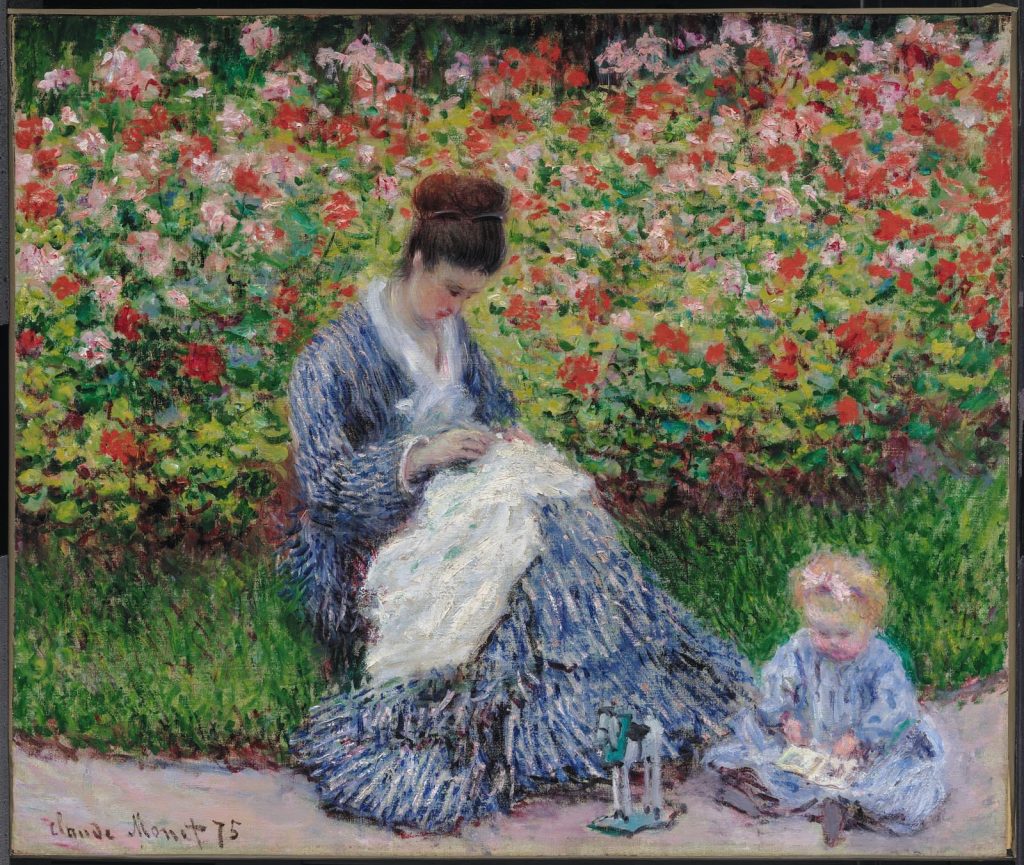
While the minute detail is little to none, the viewer can still make out what it is. In his work, Monet underlined the idea of presenting an impression of how he perceived the world, a position that artists of the past did not acknowledge. The name Impressionism actually came from a critique where someone called his work, Impression Sunrise, just an impression and not something you could call art (Auricchio). That name stuck and the movement was based on it and grew. The short, broken brush strokes that barely conveyed form made up of unblended colors and put an emphasis on light were now on par with the historical paintings that were adored by the Salons.
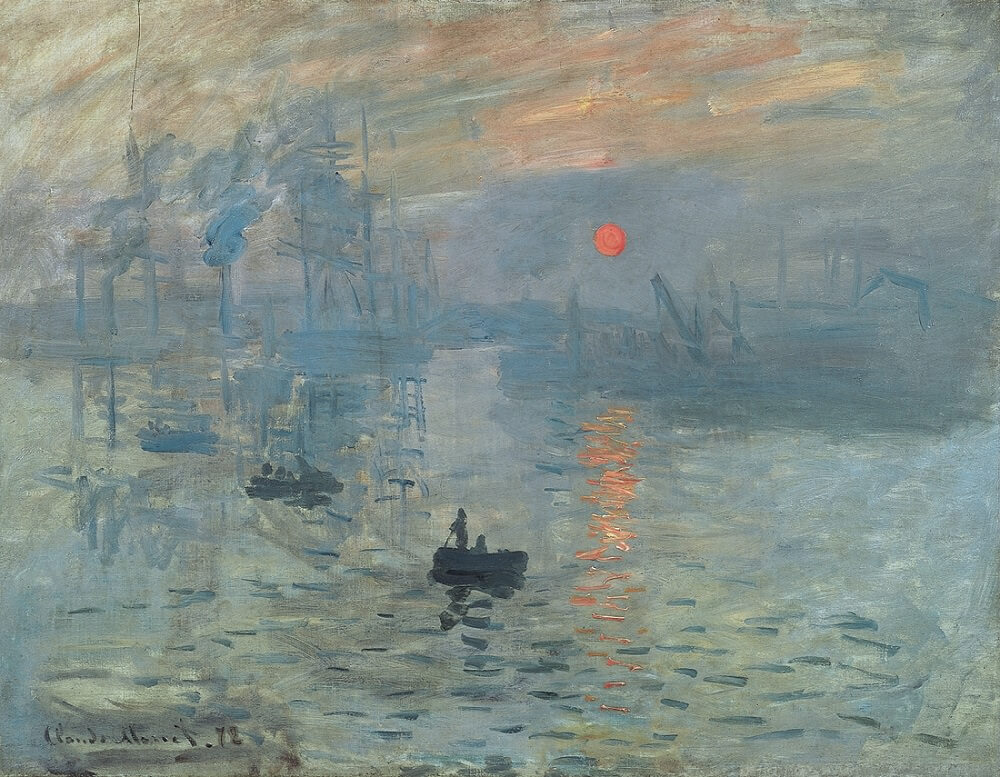
Like other Impressionist artists, Monet started out by painting the middle and wealthy class while they took part in leisure activities. From sight-seeing to picnicking, Monet captured all of it in his unique style but as time went on, he was more interested in capturing the way nature clashed with buildings and the new innovations at the time. An example of this would be his series of paintings of the Gare Saint Lazare Station during the 1870s (Ostergaard).
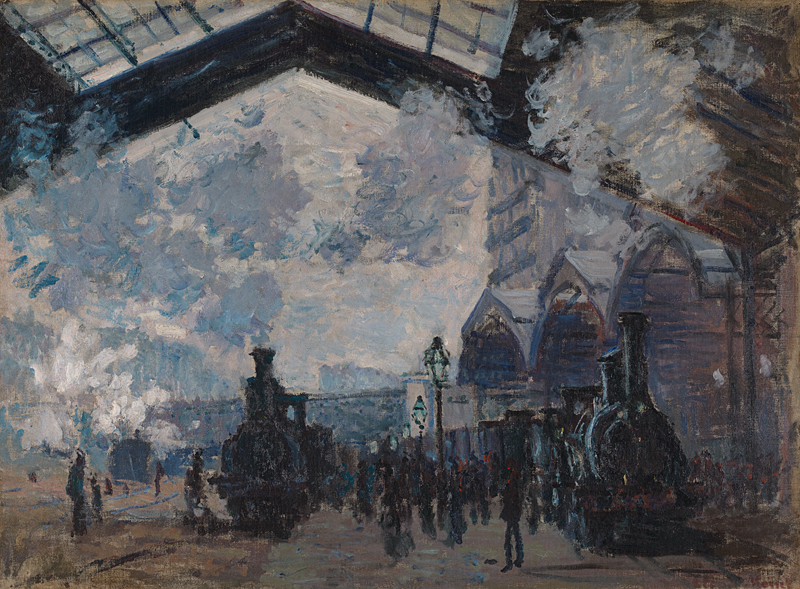
It was in the 1890s Monet started making works in series. For every series there existed a set motif under different light and weather conditions. One of these first series was created in 1876 at the Gare Saint-Lazare in Paris during winter. This work completely opposes the usual subjects of Impressionist art and instead these works portray the train and the station. As these weren’t subjects people usually related to Impressionism this piece isn’t as acclaimed as others. It is referenced to J.M.W. Turner’s Rain, Steam, and Speed—The Great Western Railway of 1844.
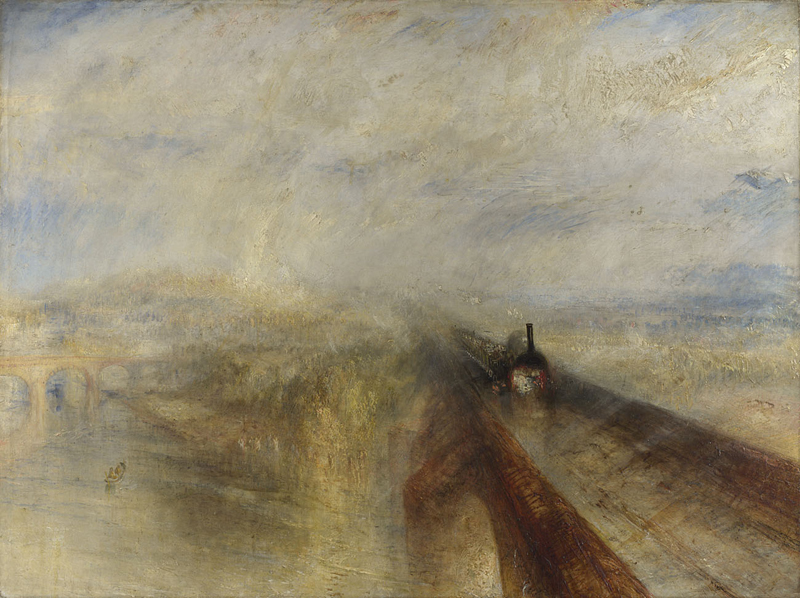
In these works Monet explored how the steam of the engines would mix with the clouds of the sky and how the people and train cars would fit into the environment. While the work was highly influenced by industrialization, it has the power of transporting you right to the platform itself just like how landscape paintings do. Monet would play with the way he rendered the air/sky and include various reds and pinks that you would not normally find during the day at the station. Another series was the Rouen Cathedral series created in the 1890s, in which he painted the Rouen Cathedral at different moments of the day (Harris & Zucker).
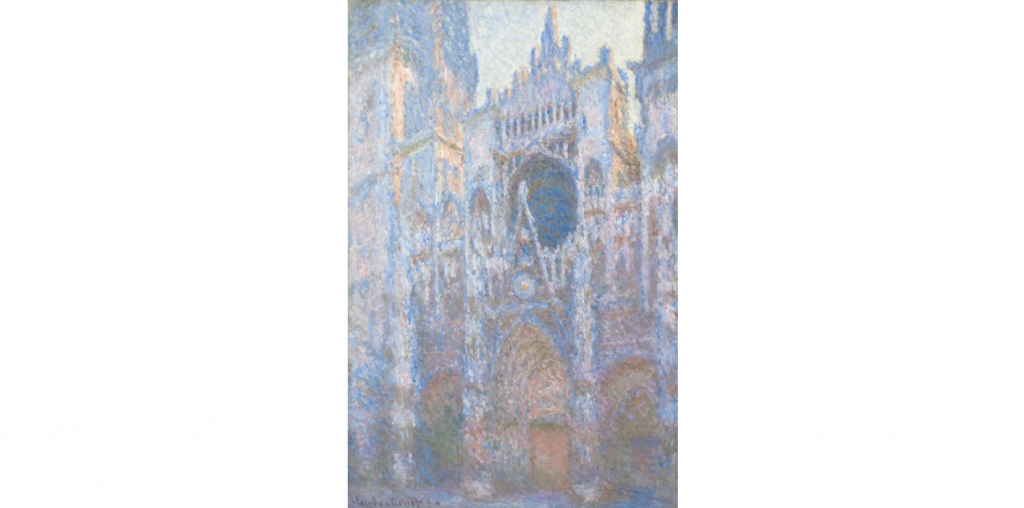
In each piece, a different color would serve as the shadows of the building, depicting the magnificent piece of architecture. Monet went outside and painted the building during different hours of the day with multiple canvases. He could only work on each one for a few hours of the day because he needed the specific lighting. His work centered on capturing how the light would hit the building. It gave the feeling of viewing the building at different times and the mood of each painting was different.
Monet was also part of the artists that were inspired by Japanese art. Looking at Japanese art at the time, it followed the same ideas of Impressionists (Asian Art Museum). The vibrant and pure colors, less attention to detail and more on form and capturing the beauty of nature. In Monet’s later works you can see the inspiration of Japanese art more since he works less with subjects that involve both human creation and nature. As time went on, Monet focused more on nature and moved a little closer to abstraction. During his latest years he worked on a series called Water Lilies during the late 1890s to his death.
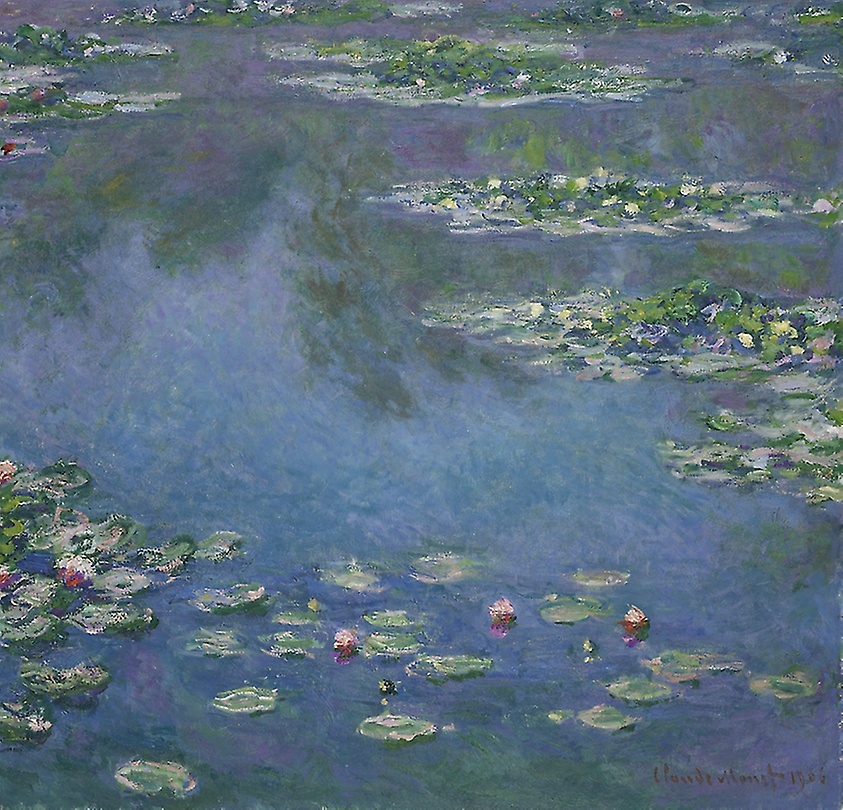
He had his own personal garden just outside of Paris in Giverny with a little pond where he could manipulate the landscape as he pleased (Auricchio). Some paintings feature the whole garden in it where you could tell what was being shown but some were framed so close that it was hard to tell what Monet was trying to show the viewer. This led to a sense of abstraction and people could debate over what Monet found so fascinating that he had to paint it in such close proximity. With the indistinct brush strokes and vivid colors, Monet pushed the limits of Impressionism. It was no longer just painting landscapes outside. He took everything into account and tried to really capture the essence of nature along with how the environment worked. He showed the world that it does not matter what you are painting, it matters how you paint it.
Timeline
1845– Moving to Le Havre Normandy with his family, Monet discovered he wants to be an artist. 1851– Monet attended the Le Havre secondary school of arts. 1856– “En plain air” was the first painting lesson Monet take. 1858– The “View from Rouelles” was the first painting he created at the age of 22.

1861– Monet took a pause on painting, after joining the military. 1866– The “woman in a green dress” also known as the “Camille” was a piece of art that was showed in the salon.

1870– Monet moved to England, after the Franco-Prussian war began, he also got married to Camille Doncieux. 1871– A year after he moved to the Netherlands and further is painting career. 1872– The “impression, Sunrise” was created in April and influence the impressionist movement. 1875– Monet paints “Woman with a Parasol”. 1879– Monet wife, Camille dies. 1890– Monet began a series of paintings of haystacks. 1892– Monet marries Alice Hoschede and he began the painting of the Rouen Cathedral. 1897– Monet created the water Lilies painting. 1900– The house of parliament series began.

1908– Monet travel to Venice and paints the “View of San Giorgio Maggiore” 1911– Alice passed away 1916– Monet begins painting the large-scale water lilies series. 1926– Monet died at the age of 86.
Artworks


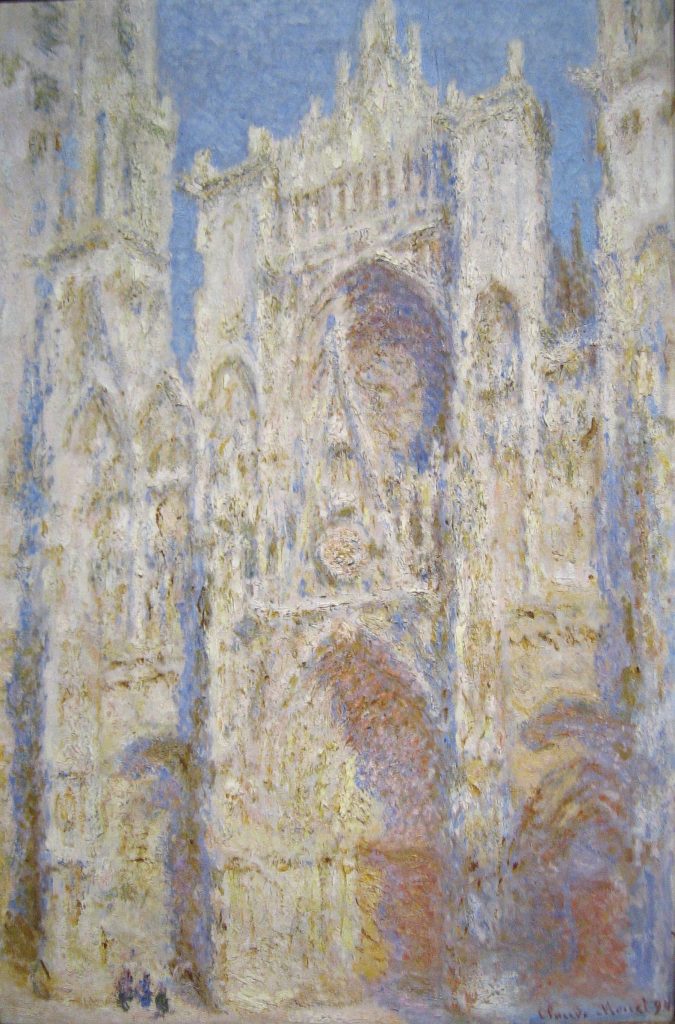
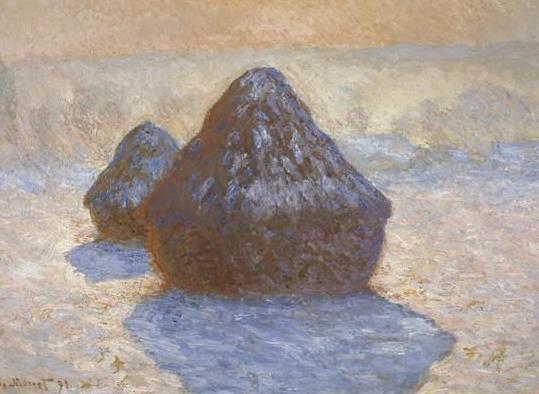
Inspirations & Artist Circle
Claude Monet drew much of his inspiration later in life from the childhood he had. When still a boy he and his family moved to the Normandy coast near a town called Le Harve. They’d moved here because of his father’s business plans. Here is where Monet got a vast exposure and intimate knowledge of the sea and the rapidly shifting Norman weather, that would one day give rise to his fresh vision of nature. This would later be seen throughout his works but It should also be mentioned that In these early years he also executed pencil sketches of sailing ships, which were almost technical in their clear descriptiveness.
One of Claude Monet’s earliest inspirations was one of his close friends when he was still in his teens. The man’s name was Eugene Boudin who was known for his landscape paintings and though he did not end up being as famous as Monet he was the one who opened Monet’s eyes to painting and specifically plein air painting for which Monet became renown. Monet had been was primarily focused on drawing caricatures with charcoal and was becoming well known for that but Boudin insisted he focus on becoming a “real” artist.
It is said that Monet used his inspiration from the first time he went to paint with Boudin as the basis of what would eventually lead to him creating the very first impressionist painting — and to make studies of light as it fell on haystacks, a cathedral, and — eventually — tangles of water lilies, floating in a pond.
As previously noted, one of Monet’s other huge inspirations for his work was nature and this is evident in numerous of his works such as The Water Lily Pond, Sunrise, haystacks, and many more.
The artists and writers Monet surrounded himself with were: Pierre-Auguste Renoir,Frédéric Bazille, Charles Baudelaire, Alfred Sisley,Émile Zola, Paul Durand-Ruel

Contrasts and Similarities to Works of Different Genres:
Impressionism vs Realism

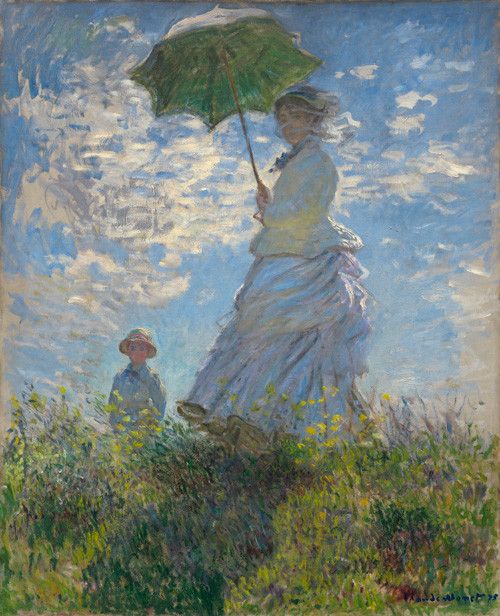
Impressionism was born as a response to Realism. Realism focused on making a statement, exploring controversies, and showing the struggles of the working class. It put importance on form, structure, and artistic rules to represent reality as accurately as possible. But due to the popularity of photography, painting things as they are has become redundant. Impressionism relaxed these rules and sought to add value to reality and provide an angle that a camera could not capture. Monet expresses this through his painting style and process.
Claude Monet’s early works featured the leisurely activities of the middle class and the wealthy. It emphasized beauty and serenity as seen in Monet’s Woman with a Parasol which depicted Monet’s wife and son strolling in a park. She appears to have turned to look at the audience just as a gust of wind blows in from the right making her parasol tilt, dress sway, and foliage flutter. Even the clouds seem to be in motion as they swirl ever so slightly. By capturing this fleeting moment in a painting, Monet had surpassed the abilities of a camera that could take up to a few minutes and required the subject to stay still and posed. Most paintings before Impressionism depicted people in portraits and women were never shown making direct eye contact with the audience as it was perceived to be too bold. But by countering this tradition, Monet was able to capture movement and show the elegant way he viewed his family while also engaging the audience into the painting – her expression conveys that Madame Monet had just noticed our gaze as we interrupted her stroll with her son.
In contrast, Édouard Manet’s A Bar at the Folies-Bergère explores a controversial side to his female subject. The painting captures a scene at a bar that was notorious for prostitution. A female bartender appears to be looking directly at us but is actually attending a customer as seen in the mirror behind her. The mirror also shows a crowd of drunk men and women enjoying the services of the restaurant, but despite all the commotion around her, the bartender seems unfazed. The woman’s detachment from the environment she was in was a commentary on her job and role and it stirred controversy. Visually both paintings appear to use different techniques – Manet’s painting is more detailed, emphasizes the subjects’ facial features, and mainly uses neutral colors, whereas Monet’s painting looks flowy, focuses on the shape of the brushstroke, and has bright colors. But on closer inspection, some elements of Impressionism can be seen in Manet’s work that Monet later reflects in his own. While the foreground displays a variety of wine and fruits painted in high detail as is expected of realist artworks, the mirror in the background is painted with impressionist philosophies and captures only the essence of the crowd in the bar by blending the colors and emphasizing light, shadows, and natural blurs. Manet’s work was known to be crucial to the transition of art between Realism and Impressionism.
Impressionism vs Post-impressionism
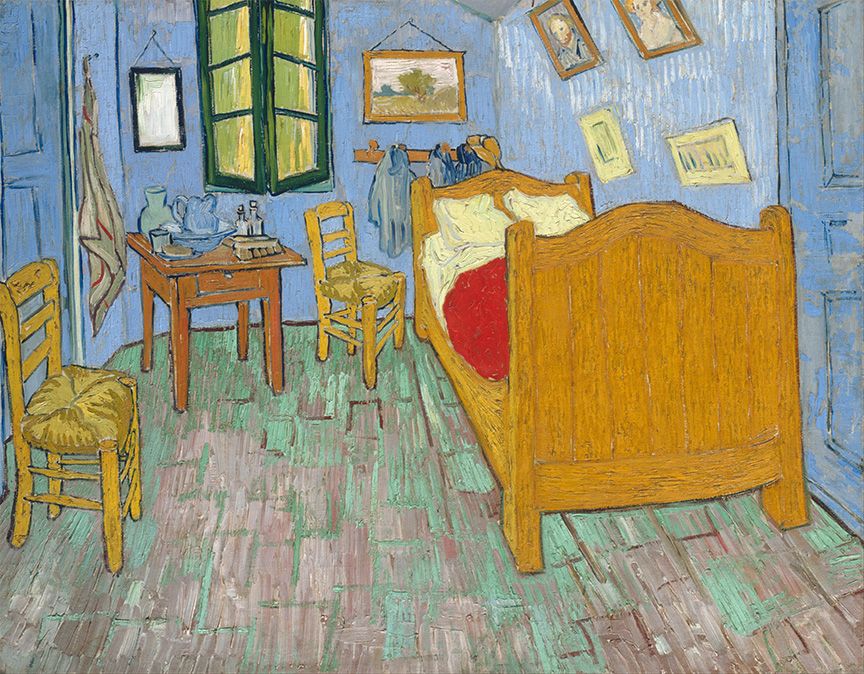
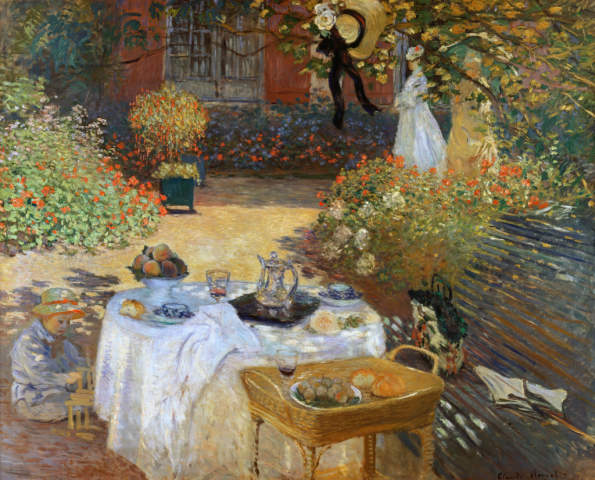
Post-Impressionism encompasses the shift in artistic values that had occurred immediately after the peak of Impressionism. It retained many impressionist ideals while freeing itself of impressionist limitations. Because of this, it is difficult to categorize paintings of this genre into a single style, since many attributes of both Realism and Impressionism can be found in paintings of this movement. Like Impressionism, there was a heavy emphasis on color and brushstroke and most subjects of this genre focused on portraying beauty rather than making a controversial statement. But there was also an increased clarity of form, line, and other formal structure as seen in Realism. Both of the paintings above focus on a subject that holds sentiment to the artist and explores an aspect of everyday life and normality. Claude Monet’s The Luncheon shows a moment of his day where both his wife and son are at leisure, and a table had not been cleared of plates leftover from a meal. The style is picturesque and the shadows accurately highlight the bright light of the afternoon. The lack of organization as seen by the messy table, a stray hat, etc. makes the scene more natural and genuine to an everyday lifestyle instead of appearing posed for a picture. That rough and natural everyday element is also seen in Vincent Van Gogh’s painting Bedroom in Arles which visualizes a modest bedroom with minimal furniture, toiletries, a few painting fixtures on the walls, and regular disorder of a room that’s used. Everything also seems slightly askew and the shapes have bold defining lines that defy impressionism. But when zoomed in, the brush strokes of paint on the furniture and pillows create a 3-dimensional texture to them, which is reminiscent of Monet’s stylistic. The bright colors used in this piece adds personality to the simplicity of the subject. Even the wear on the wooden floorboards showing the room’s age and lack of care is perfectly captured with the unusual color choice of mauve and light green. Both paintings aim to depict tranquility and relax the audience. The post-impressionist style is a re-interpretation of Impressionism.
Impressionism vs Impressionism
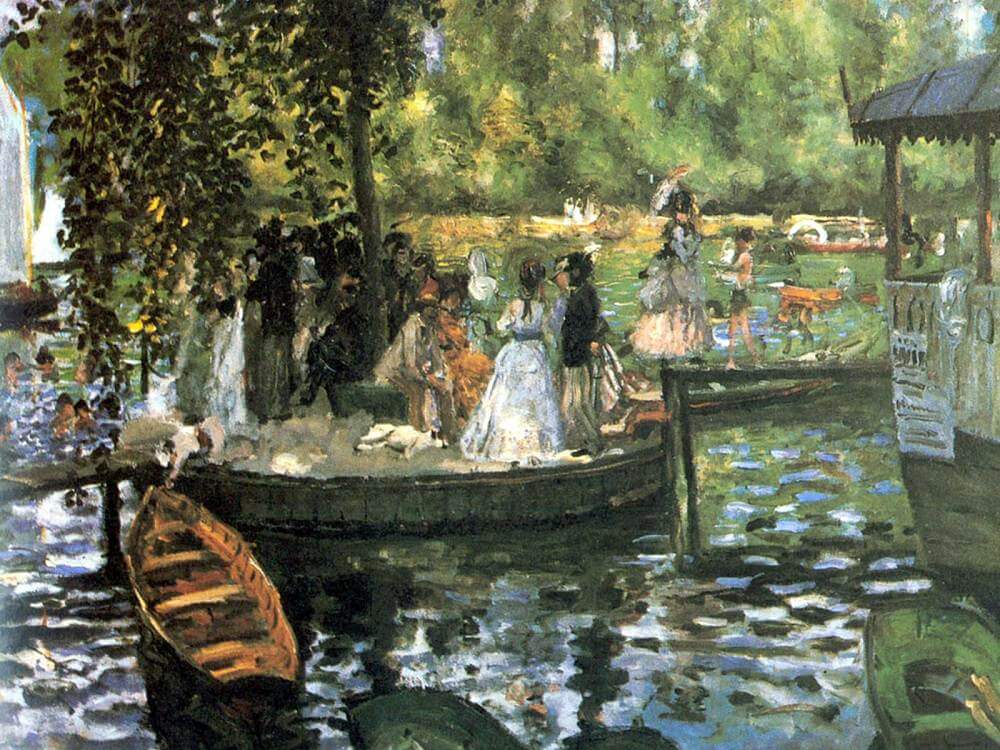
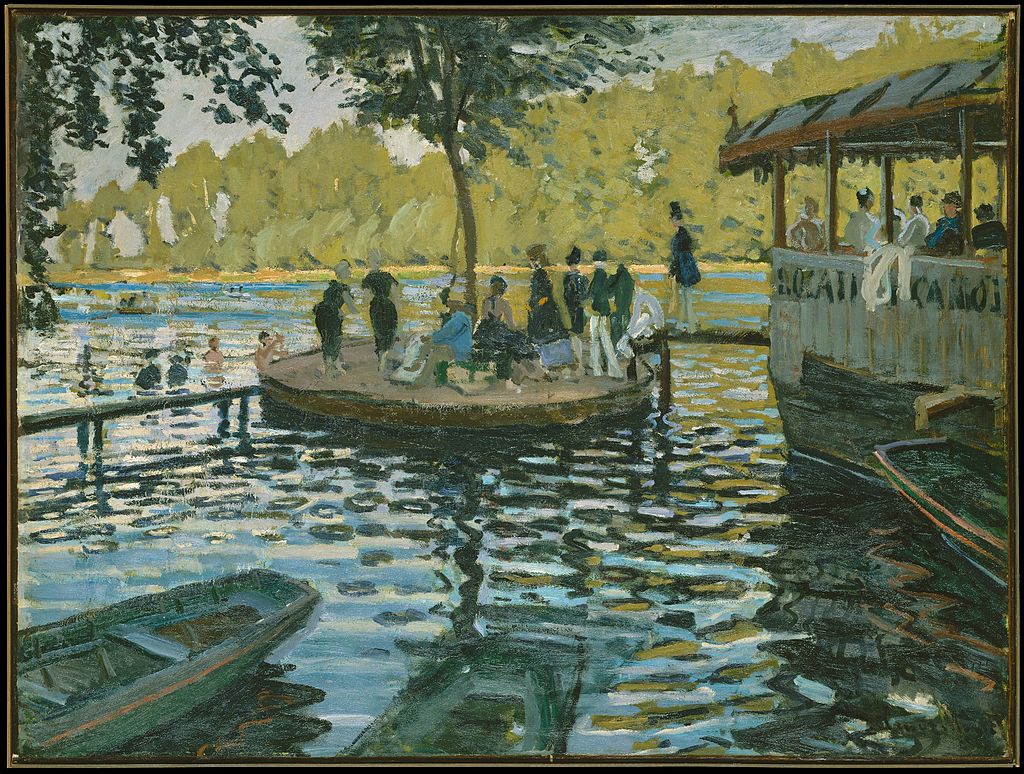
Even within the genre of Impressionism, Monet had a distinct stylistic and unique perspective towards his subjects. This is evident when compared to the works of Pierre Auguste Renoir. Renoir was a French painter who had an eye for beauty and rivaled Monet’s prowess in Impressionism. Monet and Renoir were also good friends and they often painted together. The two paintings above are their individual depictions of La Grenouillère, a boating resort on the Seine river. Despite being of the same scene, their artistic priorities differ as Renoir’s painting looks scenic and narrative while Monet’s looks like a study of shape and form. In Renoir’s version, most of his effort goes into painting the foreground as seen by the hanging leaves and individual characters on the island. He diminishes the landscape and uses it as a support to his characters. The background is just a blur of green and gray with highlights. His brushstrokes are small and blend easily with each other, and though the lighting is delicate, it’s a significant element that emphasizes the sunshine through the leaves by falling on the woman’s dress and around the dock. In Monet’s version, the people are represented with broad brush strokes and have only a slight indication of being people through color and general shapes. Similar to Renoir, there’s not much emphasis on the background, but Monet does not blend the strokes as smoothly. The paint has texture and the brush is deliberately noticeable because the smears of the brush strokes substitute for the shapes of the foliage in the background. A larger emphasis is placed on the water which looks hyper realistic compared to the rest of the work. While Renoir’s work has more detail compared to Monet’s, they both are impressionistic as they capture a fleeting moment and study the nature of light.
Contributions and Impact on Artistic World
In 1874, Claude Monet exhibited The Impression Sunrise which made him one of the leading figures in the impressionist movement in 19th century. The reason why the movement became revolutionary was because it broke the rules of beaux-art or how detailed the paintings should be created and the movement set new standards of how the artists viewed nature and it gave them more freedom to depict nature as they saw it. The loose brushwork and the use of non-natural color in the paintings later gave rise to movements like post-impressionism, neo-impressionism and expressionism.
Post impressionists extended impressionism, by following similar patterns as using vivid colors, real life subject matter and discernible, broad brushstrokes but they used distort forms, unnatural and random colors to convey emotions which went against impressionism’s natural depiction of light and color. Expressionism broke away from showing the actual representation of nature to express the state of mind of the artist. It used distortion and exaggeration to capture the emotional state of the subject matter rather than focusing on the impression. Neo-impressionism tried to refine the instinctive artistic mannerisms of impressionism, they used a different approach to capture light and color. Instead of individual brushstrokes they used a collection of dots with individual colors. The mixture of color happened in the spectator’s eye as an “optical mixture” to show the natural look of landscapes and cities.

Monet’s style of painting influenced other artists, such as Camille Pissarro, Pierre-Auguste Renoir, and Paul Cezanne. Renoir was influenced by Monet’s subjective perspective of light but he was more inclined towards painting people rather than landscapes, Renoir had a greater affinity for classical techniques which can be seen in La Grenouillere. Later He breaks away from the movement to use a more disciplined technique on portraits.
Camille Pissarro stayed dedicated to the impressionism style paintings, and was a key figure in the Impressionist movement but he did experiment with other styles like neo-impressionism. He would create paintings of the effects of fog, snow, and springtime. Later he tried using neo-impressionism techniques like pointillism. Paul Cezanne began to approach his subjects the way Monet did but was more attentive to the atmospheric quality of light which can be seen in his early works like The Wine Market (1872) and exhibited his works in 1874 with Monet. He was inspired by Monet’s art of subjective perception but rejected the brushwork and favored organized compositions and later developed his style of post-impressionism.
Monet’s and his oeuvre remain influential and popular among modern audiences. At auctions, his paintings are sold for high bids. His paintings are now held in major art galleries and museums all over the world. Even after his time, Impressionism and plein air painting has become a major art style and technique that continues to be used by artists. He was one of the first who revolted against the tradition of classical art like romanticism. His subjective perception gave birth to a trend of trying something new which was the foundation of modern art and 20th century art movements. In one of the recent auctions the painting “Haystacks” which had an estimated value of $55 million was sold for $110.7 million making it the first impressionist painting to surpass $100 million.